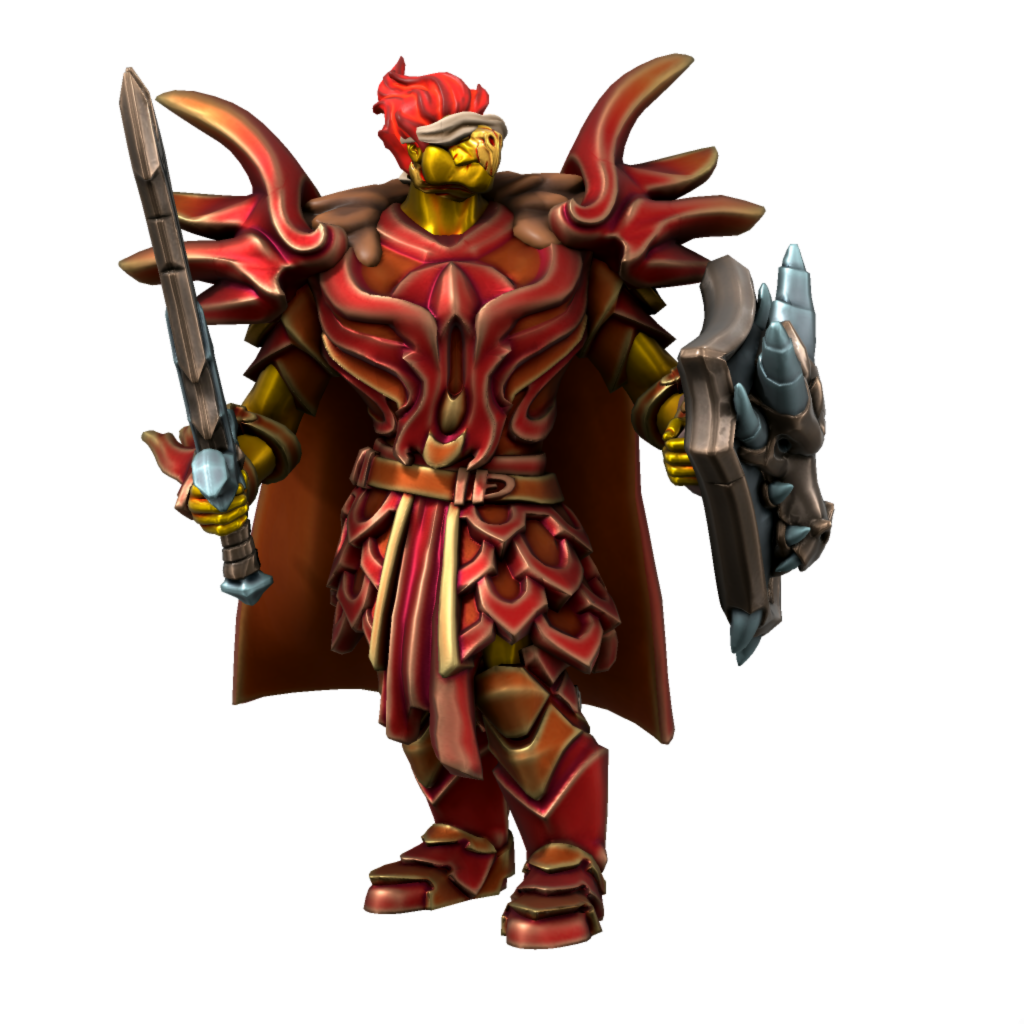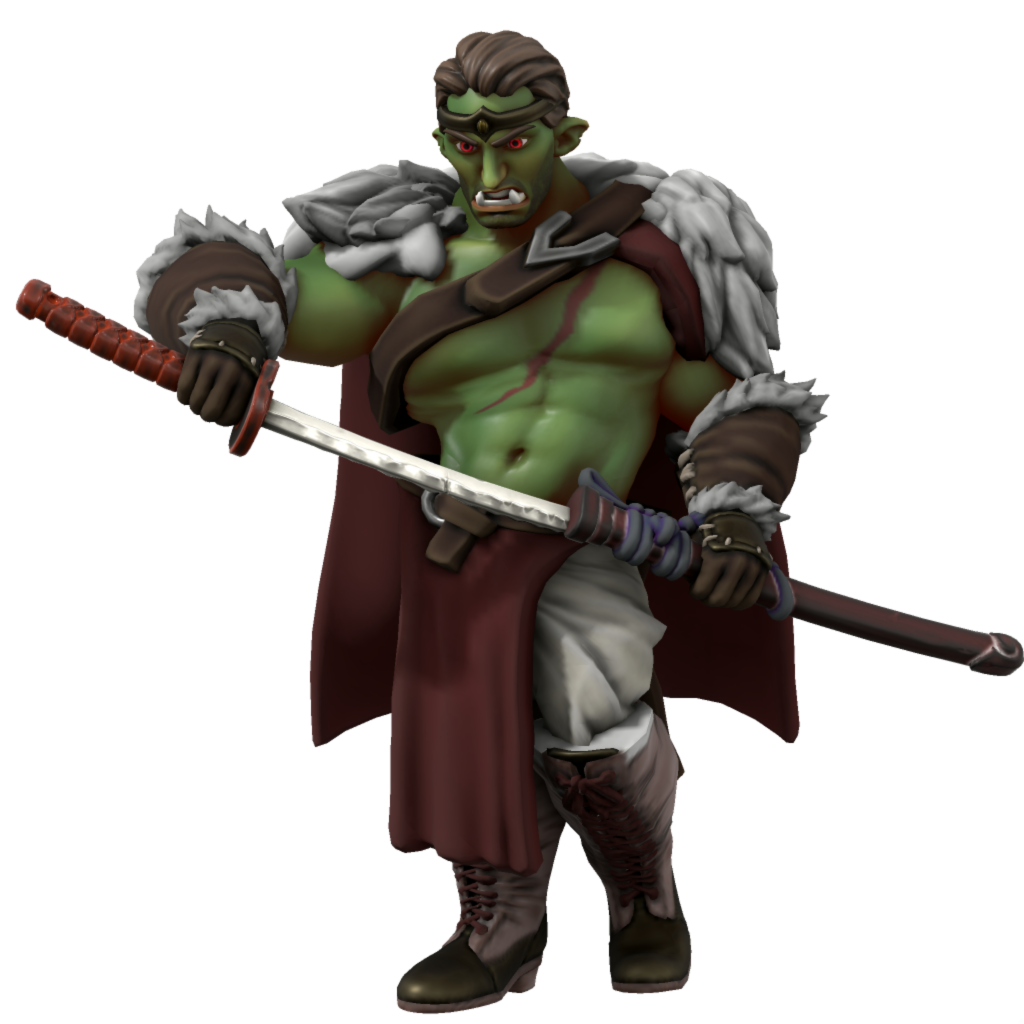However, without the Empress appointing them, the judges began to be less and less alligned ideologically with her. They realized they could interpret the laws however they wanted, and slowly but surely began stripping power from the Empress and granting it to themselves.
Soon, the Court of Mercy was not subordinate, but equal to the Empress. For a time, they were complacent with that position.
Commonbrush Reforms
It was around that time that a new figure arrived in the Court of Mercy:
Korras Commonbrush. Korras was a low-ranking judge with the court, as he was a recent addition, but he immediately began spreading new ideas to the court.
The major reform he suggested was to ditch being entirely composed of Halflings. If they wanted any legitimacy on the world stage, they should be a court for everyone.
"Stallbourne is the largest city in the world, housing more than just Halflings, and those that do not yet live here have a place to. If we can have voices from all over the world, we could truly be a global entity.
In that way, we could influence the world at large and, if the Empress so wishes, have more claim to the land. More than that, new perspectives means a more robust view of justice."— Korras Commonbrush
The other judges agreed, some for the same reasons as Korras, but others because it suited one of their plans.
The Court of Mercy had seized property at the very center of Stallbourne, destroying everything that stood there so they could build a tower for themselves in the space. To fund this tower, which the Empress refused to pay for, they wanted outside funding. Besides, the Helft Empire had been spreading itself thin across Western Elone building new cities and waging wars.
The first ones to agree were the
Secci Gnomes, closely followed by the
Draconians. The Gnomes simply liked the idea and thought it could give them more influence, while the Draconians appreciated getting a say in this court, introducing their God of Justice, Phrixus, to the Court. The Court immediately took to Phrixus's ideals.
The Goblins and Emetians refused the offer, and the Court of Mercy simply accepted this, not believing it was worth bringing them in if they didn't want it. This was not the same with the
Elves, who refused to help. The Court of Mercy, who initially wanted the Halflings to stay leading the court, agreed to have all judges hold a voice on the same level as the others, and the Elves agreed.

Phrixus by Jarhed
Not long after the Elves agreed, the
Dwarves jumped on the opportunity. They had been at war with the Helft Empire, but they saw that as a battle against the Empress, and figured joining the Court could undermine her power.
The
Mammen were next, as they held a crucial port across the
Strait of Ildial west of Stallbourne, and from that the Kamejin closely followed at the other end of Elone, as they controlled access to the sea to the east of Elone. With global reach now, the Court considered stopping, but Korras decided this was not an accurate picture of the world yet.
Then, the Southern Nereids that lived right in the sea outside of Stallbourne were invited.
Finally, the Court of Mercy invited four more species from Udai. First, it was the
Korvians, who had great influence among the Beastmen. Then, reluctantly, they invited the
Orcs. They knew the Orcs were crucial, but did not know if they were suited to a Court setting.
The
Ophidians, then, came about because of the growing Ophidian nation that would soon expand into a monstrous rival on the opposite end of Elone. The Empress particularly warned against this, but the Court refused to listen to her at this point, adding the Ophidians.
The final species to join the Court of Mercy were the
Lizardfolk. A struggling nation in
Udai, the Court of Mercy hoped to help them stay afloat and gain their aid on their own continent of Elone.
The tower was fully funded, being built in the shape of scales and coming to be known as
The Marshal. Now, with only one Halfling on the Court, others took up different positions. Korras Commonbrush took on the role of an enforcer for the Court, taking on the same title as the tower, being the first Marshal of the Court.
Alongside this, Korras reformed the way they did trials, making what were once public spectacles into private decisions that would be published in records later on. This made decisions less subject to public influence and more about the actual justice of the case.
The Rulers of Stallbourne
The Commonbrush Reforms that Korras suggested did not come without concessions. He had to give in to the other judges ambition.
At the time, the Empress was busy in other cities with wars, and she was losing. The Court of Mercy decided that they were done being equal with the Empress, and seized power over Stallbourne while she wasn't there. All other public offices were vacated and replaced with those loyal to the Court, either former judges or foreign agents that had come after the Commonbrush Reforms.
They didn't bother concerning themselves with the rest of the Helft Empire, seceding with just Stallbourne and becoming the sole rulers of the largest city in the world, taking with it the strategic and geographical importance of the land.
The Empress attempted to leave behind her war with the Dwarves and Goblins to take her city back, but ultimately she was killed before returning to Stallbourne. Whether it was the Goblins, Dwarves, or even the Court of Mercy that did her in is unknown, but the Court officially released a statement saying:
"It was a mercy that someone put the Empress of Elone out of her misery before she realized the futility of her dream and before the crimes of her war could be prosecuted. An official state funeral will be held next week, but the Court of Mercy has no plans to take up the reigns on the remainder of the failing Helft Empire."— The Court of Mercy
The other settlements were destroyed or taken over, and the Helft Empire collapsed, leaving only Stallbourne and its Court of Mercy.
The Court of Mercy did expand beyond Stallbourne, taking control over an island off the coast that had strange properties to it that granted immortality while on it, deciding to leave it barren until they could find something to do with it.

Amukk by Jarhed
Name Origin
The name for the Stallbourne Court of Mercy came from two places, and later was given new meaning by an important figure. Of course, its first place of origin is the city of Stallbourne where they came from.
The second was part of their initial role. The Empress rarely expected radical rulings, generally handing off cases to the Court for them to grant merciful punishments to criminals. It was only as the court started getting more power that this mercy grew more and more twisted.
However, they began embracing mercy more when the Orcish warrior
Amukk came onto the scene, a man who led an army of people from around the world, the
United Holy Front, in what he called "The War of Mercy." While he did not ever go to Stallbourne as far as anyone was aware, he had taken on the mission of mercy when the Court didn't.
Due to his popularity, the Court of Mercy not only embraced their name, but sent a representative,
Korras Commonbrush, to aid Amukk.
They kept the name for 15 years as they supported Amukk, even embracing his faith when he became a God. They officially followed the laws of two faiths:
Phrixus, the
Draconian God of Justice and Protection, and Amukk, now the Orcish God of Justice and Mercy.
All of this only to change their name not long after Amukk ascended to Heaven.
The World Court
There is little explanation for how Humanity arrived on Totania, but in the year -10, they appeared in northern Elone.

Gellark Lionrage by Jarhed
Whatever the case, the Court of Mercy refused to aid them in their struggles. When petitioned to relocate the Humans so they were not interfering with the Goblins and had a place of their own to settle, the Court of Mercy refused. When petitioned to send aid to help Humanity survive, the Court of Mercy refused.
They were only spurred to actions when Varth Dreamless began rampaging across Elone with divine power at his side, only being stalled by
Gellark Lionrage. The Court of Mercy sent a joint force to stop Varth, but even they were unable to.
Gellark led Varth, an unstoppable killing machine, to Stallbourne so the Court would have to act, and eventually they did, imprisoning him on the island they had taken control of some few years prior, turning it into the
World Cell.
Gellark spotted the flaws in the Court, telling them of how he believed they could be reformed, particularly adding a thirteenth member so they had no chance of being split 50/50 on decisions, to which he introduced a Human as the thirteenth judge.
These changes were aided by other prominent figures. Priests of Phrixus, including Archpriest of Protecton Velthen Saseth, helped ease these changes, and Korras Commonbrush was always there to suggest ideas and make the process smoother.
This thirteenth judge ended up taking power more often than not, being a figurehead that would lead deliberation and had the final say. One judge claimed, of this:
"Gellark has reinstated the Empire, and subjugated us all under Humanity's boot."

Judge Beta by Jarhed
Gellark did become King of Humanity, but that did not extend to the Court of Mercy, now renamed to suit their global image, being called the World Court.
Amukk ascended to Heaven at this point, ushering in the year 0 and the
Age of Heroes, as per the World Court's ruling.
At the same time, the Court began wearing new robes, all homogeneous black, yellow, and purple. More mysteriously, they began blindfolding themselves and wearing masks that shrouded their face. It is said that the few people that have ever seen the faces of the World Court were cursed and arrested for eternity.
This had not been the case when they were the Court of Mercy, as Korras Commonbrush demonstrated by being a public figure who often showed his face.
No one knows what the deal with the helmets or their faces are or why that coincided with Amukk's ascension to Heaven, Gellark's reforms, and their rebranding as the World Court.
All of it happened at once, with no clear explanation.
Court of Mercy's Remnants
The Court of Mercy dissolved to become the World Court, but some parts of them still remain. They still are the sole rulers of Stallbourne, and they have all but outlawed the death penalty, saving it only for situations it is most needed for. Some death penalties still exist, such as the Warrior's Execution, where those who are particularly fond of battle are given warriors deaths by dying in a battle against the Judges.
More often than not, though, criminals are sent to the World Cell, with the most dangerous among them staying there for eternity unable to die due to the island's special properties.
Alongside this, they kept the faith of Amukk and his Justice, distorting it but remaining officially supported by his faith. Phrixus's justice, on the other hand, became a bit more shaky.
After all, it wasn't a God's justice the World Court followed. It was their own. It had been since Amukk became a God, since Gellark reformed their practices, since they began wearing those robes and masks, since they began to be called the World Court.








Comments